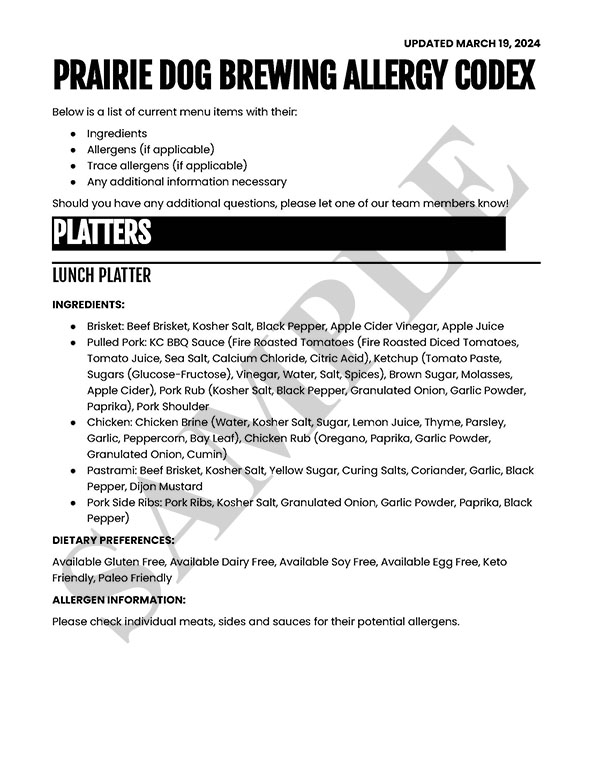Allergy Inclusivity
Our Approach To Managing Allergy Information
We believe that the person best suited to make a choice about what’s safe to eat is the person with the medical condition, but they need to be armed with accurate information to do so. Many people ask restaurant servers to check with the kitchen if a food item contains a particular allergen, but this is risky! Most kitchens have a division of labour between the team that prepares the food items and the ones that fire and assemble your order, and they often work at different times of day, so odds are that the line cooks your server talks with are not a reliable source of allergy information, at all. A Head Chef might be a reliable resource if they have an excellent memory for the the ingredients used in their prep recipes along with those used by their suppliers in pre-made ingredients, but many restaurants groups use off-site Executive Chefs who write the recipes and even sometimes off-site kitchens that prepare sauces, bake bread and desserts, etc., so you aren’t likely to find a 100% reliable source of allergens in most restaurants.
To avoid these issues altogether, our team have spent hundreds of hours meticulously combing through recipes and maintaining a catalogue of ingredients and allergy information as our “Allergy Codex” – a document that we constantly refer back to anytime a guest has an allergy outside of the most common ones. If a guest wants to know if a food items contains something like cinnamon (which happens surprisingly often), we can answer that question quickly and accurately. For common allergens, we’ve also assembled a quick matrix lookup to speed up the process of finding menu items that work. See digital versions of both documents on our Allergy Guide page.
Allergens On Our Website
We used to maintain a separate, complete list of ingredients and allergens on our website for every menu item. However, we found over time that human error was creeping in, and updates to our codex document would be updated, but information on the website would fall behind and lose accuracy, which isn’t acceptable in this space. So we’ve eliminated those ingredients lists and placed a handy icon at the top of both our food and drink menus that will take you straight to our Allergy Guide page (which has our current, detailed Allergy Codex and our simple Allergy Matrix available for download), as shown below:
Allergen vs Trace Allergen
Because our guests have a variety of sensitivity levels to food allergens, we’ve divided allergen information into two categories — allergens and trace allergens. Whenever we list something as an “allergen”, that means we deliberately include that allergen as part of the recipe, so it may be present in higher levels (like egg or dairy in a bread recipe). We list “trace allergens” in cases where foods are made with ingredients processed in facilities that also process those allergens, or where low-level cross-contamination may be possible (such as through use of our fryers, which are used to fry items containing several common allergens). If you suffer from severe food allergies, or have a medical condition like Celiac disease, you are advised to pay close attention to trace allergens. Conversely, if you have a sensitivity or intolerance, you may have no issue consuming products that could contain trace levels of the irritant. You have the power to make that decision instead of our team trying to provide medical advice.
Our Allergy Codex holds the answers that you seek.
Get Current Allergy Details Here
See our Menu Allergy Guide for full details about our menu items, their allergens and ingredients!
The Situation – Why Do We Care?
1 in 13 Canadian adults face severe food allergies, while many others have mild food allergies and potentially serious medical conditions like Celiac Disease. This makes food allergies a very serious threat to the health of Canadians, and with consequences that are perhaps even greater than those of a pandemic like Covid-19. For the people affected by serious food allergies and medical conditions, eating, and especially dining out can be risky due to unclear information. Inclusivity is paramount to our values and vision, and we go to great lengths to accommodate all guests, ensuring they can dine with less fear of allergic reactions. Our commitment to guest safety sets us apart, reflecting our core values of inclusivity and care for every individual who walks through our doors.
Prairie Dog Brewing is 100% Nut and Seafood Free!
An incident with a team member in 2019 brought food allergies top of mind for us, and we decided to to everything in our power to ensure that something like that would never happen to our team members and guests again.
Immediately, we made the call to become a nut free and fish/shellfish free facility. The incredible severity that those allergens often pose, and for such a large number of people, meant it was the only way to go as an inclusive restaurant. That meant taking a thorough look through all of our menu items, recipes and ingredients and rethinking them, including even our beer and guest alcohol, which many might overlook, for example:
- We had to replace our super-popular Caesar mix (contains shellfish) with a house-made vegan Caesar (now award-winning)
- We had to switch brands of some liqueurs and well liquor, like our Blue Curacao and gin.
- No more peanut butter or nut beers, either.
We also had to change our barbecue sauce recipes (no Worcestershire sauce, for example), and replace some of our merch, like soaps and beard oils, because they included nuts as ingredients. And finally, we had to start enforcing that guest birthday cakes and children’s snacks brought in by parents did not include nuts. We even went so far as to change our mouse trap bait! But this was just the first step in our plan.
Making An Order
If you have a food-related sensitivity or medical condition, inform our service staff as soon as you make your FIRST food/drink order (or include a comment for online orders), regardless of what you are ordering. This allows us to take extra precautions to prevent cross-contamination every step of the way between the kitchen, bar and your table. For example, you might order a gluten free cider without telling your server that you have a severe wheat allergy and think you’re safe, but the bartender or server could handle that glass with hands that just had beer spilled on them while they moved drinks onto trays, transferring those allergens onto your glass and fingers just before you eat with them.
How Your Allergy Gets Represented to Staff

Guests ordering food directly with a server or bartender in our dining room are associated with a “seat” in our Point of Sale system. If a guest tells us that they have a severe allergy or other food-related medical condition, we add a label to their seat that states something like “SOY ALLERGY”, in all-caps letters. Every time a server orders a drink or food item to your seat, the kitchen and bar staff will get a “chit”, or requisition slip, that includes the allergy text directly above the item being ordered, as pictured here. Therefore, no matter what you order, we always see the allergy information directly beside it, making it easy for us to catch errors or prevent cross-contamination.
What We Do Differently For Allergy Food Orders
First and foremost, allergy information on a kitchen or bar chit causes our staff to think about your order and validate that everything on it is compatible with the listed allergy. Servers take the extra step of confirming with the kitchen that they see the allergy on the order.
- Staff in the kitchen will create an “allergy setup” to prepare any food items that are a part of your order, including brushing and flaming portions grills where items may be cooked, getting out a dedicated set of fresh utensils for all components required to make your item.
- Some food items may be “fired” differently for customers with allergies to further reduce cross-contamination.
- Cuts of barbecue meat may be taken off a new piece of meat to assure no contamination.
- Expo staff, who manage food coming out of the kitchen and going out to tables, will double-check food items to ensure that they were made according to the allergy spec.
- Food will be run out to the dining room customer separately from other items ordered at the same table to assure that it is not confused between seats or accidentally contaminated while being transported.
- At the table, the server or food runner will confirm with the guest that they were the ones with the allergy before delivering the order to the seat.
With the extra steps, some allergy orders may take 5-10 minutes longer to prepare than normal.
We hope you understand the wait and appreciate what we’re doing to keep you safe. If you have any questions or comments, please let us know on social media @prairiedogbeer!
